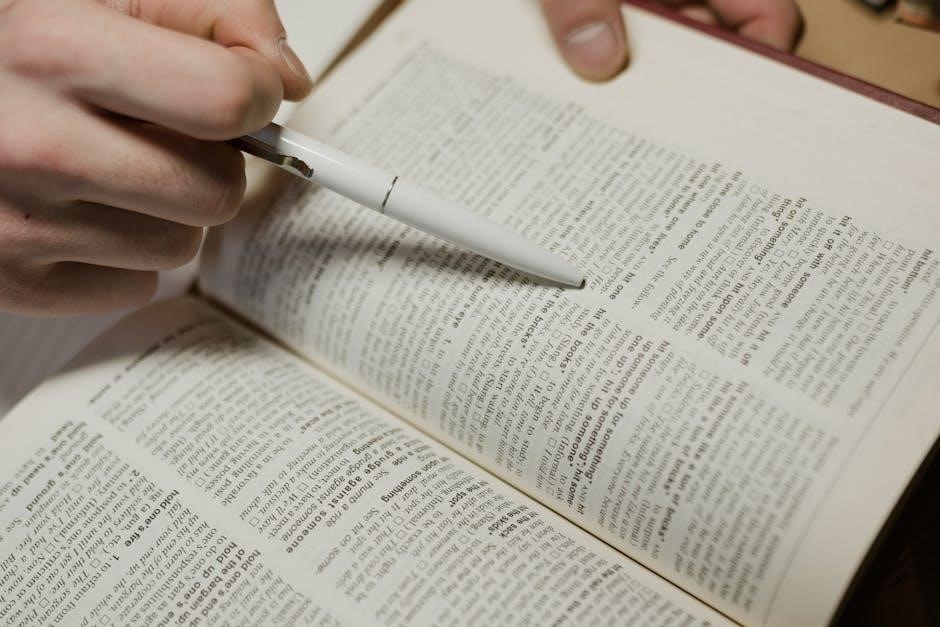Dr․ Martin Luther King Jr․ was a prominent civil rights leader‚ advocating for racial equality through nonviolent methods․ His legacy continues to inspire educational resources‚ including reading comprehension PDFs designed to engage students in understanding his impact on history and social justice․
1․1․ Who Was Martin Luther King Jr․?
Martin Luther King Jr․ was a prominent African American Baptist minister and civil rights activist․ He played a pivotal role in the American civil rights movement‚ advocating for racial equality and social justice through nonviolent methods․ Born on January 15‚ 1929‚ in Atlanta‚ Georgia‚ King became a key leader in the struggle against segregation and discrimination․ His powerful speeches‚ including the famous “I Have a Dream” address‚ continues to inspire educational resources such as reading comprehension PDFs that teach students about his life and legacy․
1․2; His Role in the Civil Rights Movement
Martin Luther King Jr․ was a central figure in the American civil rights movement‚ leading nonviolent protests and marches to combat racial segregation and inequality․ He championed landmark events like the March on Washington‚ where he delivered his iconic “I Have a Dream” speech․ His efforts culminated in significant legislative changes‚ including the Civil Rights Act and Voting Rights Act․ King’s leadership and advocacy for justice continue to inspire educational materials‚ such as reading comprehension PDFs‚ that highlight his contributions to equality and education․
1;3․ The Significance of His Legacy Today
Martin Luther King Jr․’s legacy remains profoundly impactful‚ inspiring modern civil rights and social justice movements worldwide․ His teachings on equality and nonviolence continue to influence educational materials‚ such as reading comprehension PDFs‚ which help students understand his vision for a just society․ King’s emphasis on education and leadership fosters inclusivity and critical thinking‚ ensuring his message endures for future generations․ His legacy is a cornerstone of contemporary discussions on race‚ equality‚ and the power of education to drive societal change․

Importance of Reading Comprehension
Reading comprehension enhances understanding of historical texts‚ fostering critical thinking and vocabulary growth․ It equips students to analyze MLK’s teachings‚ promoting deeper engagement with social justice themes․
2․1․ Enhancing Understanding of Historical Texts
Reading comprehension exercises about Martin Luther King Jr․ help students analyze historical texts‚ such as his speeches and biographies․ These resources‚ including PDFs‚ provide passages and questions that guide learners in understanding the context and significance of his role in the civil rights movement․ By engaging with these materials‚ students develop the ability to identify main ideas‚ supporting details‚ and the broader implications of historical events․ This skill is essential for grasping the relevance of MLK’s teachings in modern society and fostering a deeper connection to history․
2․2․ Developing Critical Thinking Skills
Reading comprehension exercises about Martin Luther King Jr․ encourage students to think critically by analyzing passages and answering questions that require deeper understanding․ These PDF resources often include prompts that ask students to evaluate the significance of events‚ compare perspectives‚ and draw conclusions․ By engaging with such materials‚ learners develop the ability to interpret complex ideas‚ identify cause-and-effect relationships‚ and form well-supported opinions․ This fosters a higher level of cognitive engagement‚ preparing students to apply critical thinking skills to real-world issues and historical contexts․
2․3․ Improving Vocabulary and Language Skills
Martin Luther King Jr․ reading comprehension PDFs often include vocabulary building exercises that expose students to key terms related to civil rights and social justice․ These resources help learners expand their lexicon by providing context clues and definitions․ By repeatedly encountering and using these words‚ students enhance their language proficiency․ Additionally‚ structured exercises encourage proper sentence structure and grammatical understanding‚ making these PDFs an effective tool for improving both reading and writing abilities in an engaging and educational manner․

Reading Comprehension Exercises About MLK
Engage students with basic and advanced passages about MLK‚ featuring multiple-choice questions‚ short answers‚ and fact/opinion exercises․ These resources cater to various grade levels and language skills․
3․1․ Basic Reading Comprehension Passages
These basic passages introduce young students to MLK’s life and legacy‚ with simple language and engaging questions․ Designed for elementary grades‚ they cover key events like his leadership in the civil rights movement and the significance of his “I Have a Dream” speech․ Activities include multiple-choice questions and word searches to reinforce learning․ The passages are ideal for building foundational comprehension skills and sparking curiosity about historical figures․ They are available as free PDF downloads for easy classroom use․
3․2․ Advanced Reading Comprehension Passages
These advanced passages delve into MLK’s complex contributions‚ such as his role in the Montgomery Bus Boycott and the March on Washington․ Designed for middle and high school students‚ they include challenging vocabulary and detailed historical contexts․ Questions and prompts encourage critical thinking about his methods and their impact․ Resources like PDF workbooks offer comprehensive exercises‚ making them ideal for deeper analysis and skill development in advanced learners․ They are available for download‚ catering to higher-grade levels and diverse learning needs․
3․3․ Fact or Opinion Questions
These exercises challenge students to identify whether statements about MLK are facts or opinions․ Questions like “MLK delivered the ‘I Have a Dream’ speech” (fact) or “MLK was the most influential leader of the civil rights movement” (opinion) promote critical thinking․ Resources like PDF workbooks include passages followed by questions‚ encouraging students to analyze and support their answers with evidence․ This activity enhances comprehension and helps students evaluate information effectively‚ making it a valuable tool for deeper learning and discussion․

Activities to Engage Students
Engage students with word searches‚ flip book craftivities‚ and classroom banners that align with MLK reading comprehension PDFs‚ fostering interactive and creative learning experiences about his life and legacy․
4․1․ Word Search and Vocabulary Building
Word search puzzles are engaging tools for students to build vocabulary while learning about MLK․ These activities‚ often included in MLK reading comprehension PDFs‚ feature key terms like “equality‚” “peace‚” and “leadership․” Students locate and circle words‚ reinforcing their understanding of MLK’s life and legacy․ This method is particularly effective for elementary students‚ as it combines fun with education‚ making complex concepts accessible and fostering a deeper connection to the material through interactive learning․
4․2․ Flip Book Craftivity for Visual Learners
A flip book craftivity is an engaging‚ hands-on activity that complements MLK reading comprehension PDFs․ Students create a visual timeline or storybook highlighting key events in MLK’s life‚ such as his famous speeches or the March on Washington․ This interactive project helps visual learners grasp complex concepts by combining art and history․ The finished flip books can be displayed in classrooms‚ fostering a sense of accomplishment and deeper understanding of MLK’s contributions to civil rights and social justice․
4․3․ Classroom Banner Activity
The classroom banner activity is a collaborative project where students create a colorful display highlighting key aspects of Martin Luther King Jr․’s life and legacy․ Using materials like construction paper‚ markers‚ and glue‚ students design panels featuring quotes‚ events‚ and themes from MLK’s journey․ This visual project complements MLK reading comprehension PDFs by reinforcing lessons learned and encouraging teamwork․ Once completed‚ the banner is displayed in the classroom‚ serving as a reminder of MLK’s impact and inspiring students to reflect on his message of unity and equality․

Resources for Different Grade Levels
MLK reading comprehension PDFs are tailored for various grade levels‚ offering age-appropriate passages and activities․ Elementary resources focus on basic understanding‚ while middle and high school materials include advanced critical thinking exercises․

5․1․ Elementary School Resources
Elementary school resources for Martin Luther King Jr․ include reading comprehension PDFs designed for young learners․ These materials feature simple‚ engaging passages about MLK’s life and legacy‚ often paired with colorful visuals and interactive activities․ Word searches‚ flip book craftivities‚ and basic comprehension questions are common․ The content is tailored to 2nd-3rd grade reading levels‚ ensuring accessibility for early readers․ These resources aim to introduce key historical concepts while fostering a love for learning through fun and educational exercises․
5․2․ Middle School Resources
Middle school resources on Martin Luther King Jr․ include advanced reading comprehension PDFs with challenging vocabulary and critical thinking exercises․ These materials feature detailed passages about MLK’s leadership and the civil rights movement‚ often paired with essay prompts․ Activities like word searches and flip book craftivities are also included․ Digital tools‚ such as interactive PDFs‚ enhance engagement․ These resources help students deepen their understanding of MLK’s significance while refining their analytical and language skills‚ preparing them for higher-level studies․
5․3․ High School Resources
High school resources for Martin Luther King Jr․ include advanced reading comprehension PDFs with complex passages and essay prompts․ These materials focus on critical analysis‚ historical context‚ and the societal impact of MLK’s work․ Vocabulary challenges and in-depth discussion questions are also included․ Digital activities‚ such as interactive PDFs‚ cater to modern learning styles․ These resources are designed to meet the demands of high school curricula‚ preparing students for standardized tests while fostering a deeper understanding of MLK’s legacy and its relevance today․

English Language Learners (ELL) Support
ELL students benefit from simplified passages and ESL-specific worksheets‚ ensuring accessibility to Martin Luther King Jr․ content while improving language skills through targeted reading comprehension exercises․
6․1․ Simplified Passages for A2/B1 Levels
For A2/B1 learners‚ simplified passages about Martin Luther King Jr․ are tailored to basic vocabulary and sentence structures․ These resources include reading comprehension exercises with multiple-choice and true/false questions․ Activities focus on essential concepts‚ such as MLK’s role in civil rights‚ his nonviolent methods‚ and the significance of his speeches․ Accompanying ESL worksheets reinforce language skills‚ ensuring accessibility for learners at these levels․ These materials align with foundational language acquisition while introducing key historical content․
6․2․ ESL Reading Comprehension Worksheets
ESL reading comprehension worksheets about Martin Luther King Jr․ are designed to support language learners․ These resources include simplified passages with key vocabulary and grammar․ Worksheets feature exercises like multiple-choice questions‚ true/false statements‚ and fill-in-the-blank activities․ They focus on understanding MLK’s life‚ his role in civil rights‚ and the impact of his speeches․ Many worksheets also include visual aids and matching exercises to reinforce learning․ Answer keys are often provided for self-assessment‚ making these tools ideal for independent study or classroom use․
6․3․ Tips for Teaching MLK to ELLs
Teaching Martin Luther King Jr․ to English Language Learners requires a focused approach․ Start with simplified passages that highlight key events and vocabulary․ Use visual aids like timelines and images to enhance understanding․ Incorporate discussion prompts that encourage students to connect MLK’s message to their own experiences․ Provide graphic organizers to help structure their thoughts․ Additionally‚ emphasize key quotes from MLK’s speeches‚ allowing students to analyze and interpret them in small groups․ This method ensures comprehension while fostering language development․

Technology-Enhanced Learning
Interactive PDFs and online tools enhance engagement‚ offering modern ways to explore MLK’s legacy․ Digital activities make learning dynamic and accessible for today’s students․
7․1․ Interactive PDFs for Engaged Learning
Interactive PDFs offer dynamic ways to explore Martin Luther King Jr․’s legacy through reading passages and comprehension exercises․ These PDFs often include multiple-choice questions‚ word searches‚ and flip book craftivities‚ making learning fun and immersive․ Designed for various grade levels‚ they cater to elementary‚ middle‚ and high school students‚ ensuring accessibility for all learners․ Features like clickable links and audio narration enhance engagement‚ while activities like timelines and vocabulary building deepen understanding․ These tools are perfect for modern classrooms‚ blending education with technology seamlessly․
7․2․ Online Reading Comprehension Tools
Online reading comprehension tools provide interactive and accessible ways to teach about Martin Luther King Jr․ These resources often include digital worksheets‚ quizzes‚ and activities that students can complete on devices․ Tools like ESL reading exercises and biography-based questions help students engage with MLK’s life and legacy․ Many platforms offer graded levels‚ from basic passages for elementary students to advanced texts for high schoolers‚ ensuring comprehension is tested appropriately․ These tools also support differentiated instruction‚ making them valuable for diverse classrooms․
7․3․ Digital Activities for Modern Classrooms
Digital activities enhance engagement by incorporating interactive elements like flip book craftivities and classroom banners that align with MLK-themed reading comprehension․ These tools allow students to visualize concepts and collaborate digitally․ For instance‚ interactive PDFs enable students to highlight key terms and answer questions within the document․ Such modern approaches cater to visual and kinesthetic learners‚ making lessons dynamic and relevant․ These activities also foster creativity while reinforcing understanding of MLK’s life and legacy‚ making learning both fun and effective․

Assessment and Evaluation
Assessment involves multiple-choice questions‚ short-answer prompts‚ and rubrics to evaluate understanding of MLK’s legacy and reading comprehension skills effectively and consistently․
8․1․ Multiple Choice Questions
Multiple choice questions are an effective way to assess students’ understanding of Martin Luther King Jr․’s life and legacy․ These questions cover key events‚ beliefs‚ and achievements‚ ensuring comprehension of the material․ They provide clear answers and distractors‚ making grading straightforward․ Students benefit from focused feedback‚ identifying areas for improvement․ This format aligns with educational goals‚ offering a structured approach to evaluation․ It is widely used in reading comprehension PDFs to measure knowledge retention and critical thinking skills effectively․
8․2․ Short Answer and Essay Prompts
Short answer and essay prompts allow students to demonstrate their understanding of Martin Luther King Jr․’s life and legacy in depth․ These prompts encourage critical thinking and analysis‚ such as explaining the significance of his “I Have a Dream” speech or discussing the impact of nonviolent resistance․ Essays enable students to explore themes like equality‚ justice‚ and leadership‚ while short answers provide focused insights into key events and ideas․ This format helps educators assess comprehension and the ability to articulate complex concepts effectively․
8․3․ Rubrics for Grading Comprehension
Rubrics for grading comprehension provide clear criteria to assess student understanding of Martin Luther King Jr․’s life and legacy․ They evaluate elements like accuracy‚ critical thinking‚ and the ability to connect historical events to modern issues․ Rubrics ensure consistency in grading and help students understand expectations․ By aligning with learning objectives‚ they promote fairness and transparency‚ enabling educators to track progress effectively and provide constructive feedback tailored to individual needs․

The Impact of MLK’s Legacy Today
Martin Luther King Jr․’s legacy continues to inspire modern movements for equality and justice․ His principles remain central to educational resources‚ fostering understanding and activism across generations․
9․1․ Continuing the Fight for Equality
Martin Luther King Jr․’s vision of equality remains a cornerstone of modern social justice movements․ Reading comprehension resources about his life and work empower students to understand the ongoing struggle for civil rights․ These materials highlight how his nonviolent resistance continues to inspire activists today․ By studying MLK’s legacy‚ learners gain insights into the importance of perseverance in achieving societal change and equality for all․ His message endures‚ motivating future generations to carry forward the fight against discrimination and injustice․
9․2․ Inspiring Future Generations
Martin Luther King Jr․’s message of hope and equality continues to inspire young learners through reading comprehension PDFs and educational resources․ These materials introduce students to his life‚ speeches‚ and the impact of his work; By engaging with passages about his legacy‚ students develop critical thinking skills and a deeper understanding of social justice․ Interactive activities‚ such as word searches and comprehension exercises‚ make learning about MLK fun and accessible․ This fosters empathy and motivates students to become agents of change in their own communities․
9․3․ MLK’s Influence on Modern Education
Martin Luther King Jr․’s principles of equality and justice have shaped modern educational practices and materials․ Reading comprehension PDFs about his life and legacy are widely used in classrooms to teach critical thinking and cultural awareness․ These resources‚ available for various grade levels‚ include passages‚ activities‚ and assessments that align with curriculum standards․ By integrating MLK’s story‚ educators promote diversity‚ inclusion‚ and social responsibility‚ ensuring his impact remains relevant and transformative in today’s educational landscape․
